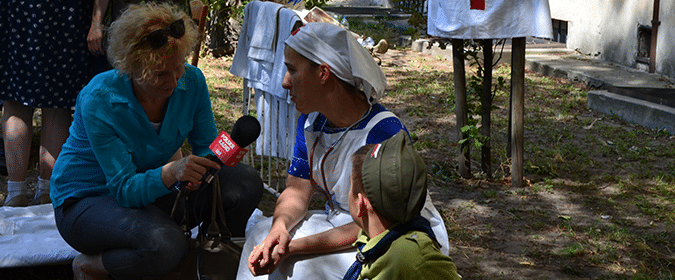
When journalist Kim Wall was murdered while working on a story last year, the world took notice of the dangers women face simply to report the news. But while Wall’s murder generated a significant number of headlines and she suffered a uniquely tragic end, her story didn’t shock other women in the field as much as it did the general public. That’s because women around the globe put themselves in harm’s way each and every day to report the news, and even when things go badly, they rarely become the story. The International Women’s Media Foundation (IWMF) is working to change that by bringing attention to the dangers female journalists face, training women to better protect themselves and funding women journalists who put their lives on the line to deliver the news.
Founded in 1990, IWMF has spent nearly 30 years working to help women find their footing in the media world and protect themselves once they get there. Now headed by Executive Director Elisa Lees Muñoz, the foundation has spent millions of dollars and thousands of hours helping to support women who are reporting around the world. From individual grants to emergency funds to safety and reporting training sessions, the IWMF has helped journalists tell stories that would not otherwise be told and kept them safe in the process.
“The one thing that I’m always astounded by is the calling of journalism. You know it is not a job. It is not a profession. It’s a calling that that brings with it so many sacrifices that these women make happily and gladly, and they do it again and again and again,” Muñoz says. “Our courage winners, for example, sacrifice so much. Their families are threatened, they’re threatened, they’re imprisoned. And yet when they get out of prison, they go back out and they [keep reporting]. And so, you can’t help but be in awe of these women and want to support them 24/7.”
While many of the IWMF’s programs are focused on helping U.S. reporters when they’re traveling abroad for stories, the foundation also runs a number of training and security workshops for local journalists internationally. In Africa, for example, IWMF works with local security teams and journalists to train local reporters in quarterly workshops and provide year-long support.
“We work through our local contacts and our huge network of journalists and we ask, ‘Hey, who do you know in Juba [South Sudan] who’s a promising young journalist?’ and remarkably we get more names than we can support, because there are so many driven and talented young journalists all over the world who just need a little bit more training,” Muñoz says of the in-country training IWMF offers. “Some of these journalists haven’t gone to university, haven’t been formally trained, but have been out there reporting.
“I can’t imagine a more demanding place to operate than in Juba, where sometimes they can’t go to a place to report a story because of their ethnicity. It’s really very, very hostile. But it’s also very hostile because they’re women,” Muñoz continues. “These are places where women normally don’t work as journalists, where their culture is hostile to them being out there and asking questions.”
Muñoz finds it especially troublesome that so many programs that exist for journalists in these regions aren’t reaching out to women more, the way IWMF does. While she applauds any efforts to help journalists do their jobs safely, especially in developing countries and in combat zones around the world, the fact that many of the programs offered don’t have many women participating worries her.
“We have a lot of colleagues who do wonderful work around the world who have maybe 10 percent of their program participants as women, or 20 percent, and they say to us, ‘We have a goal that by 2020 we want 50 percent of our programs to be women. And honestly, we’re a little bit flabbergasted because we don’t really understand why they can’t do it today,” Muñoz explains. “Our programs are 100 percent women and they’re the cream of the crop. They’re not less qualified than the men. It’s just that you have to go out of your way to find them, especially in these environments, but they can be found and they’re worth finding because they’re really quite remarkable.
“The lens through which we’re seeing the world is mostly white and it’s mostly male. Even the lens through which we’re seeing Africa,” Muñoz adds. “I don’t know how the rest of the world feels, but it’s a disturbing notion that we still live in an environment that is so underrepresented by the majority of the people who inhabit it.”
To continue to encourage women journalists and aid in creating a more diverse news landscape, IWMF recently awarded their inaugural grant from the Kim Wall Memorial Fund, honoring the woman who brought so much attention to the dangers female journalists face on the job. Along with the other grants offered by IWMF, the Wall Memorial Fund will help female storytellers find and break stories that only they can tell. You can read more about the IWMF’s training and grant opportunities here.
